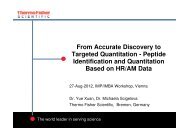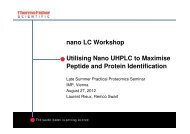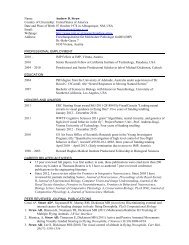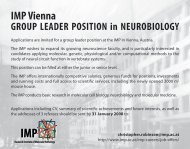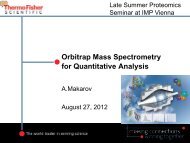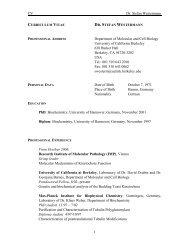IMP Research Report 2002
IMP Research Report 2002
IMP Research Report 2002
Create successful ePaper yourself
Turn your PDF publications into a flip-book with our unique Google optimized e-Paper software.
y separase at the onset of anaphase. We have found<br />
that in vertebrates cohesin begins to dissociate from<br />
chromosome arms in prophase and from centromeres<br />
at the onset of anaphase; the latter event coincides<br />
with cleavage of cohesin by separase and is essential<br />
for anaphase. Cohesin dissociation in prophase<br />
depends on Polo-like kinase (Plk1) but not on separase<br />
and is mediated at least in part by cohesin<br />
phosphorylation (Figure 2).<br />
within the APC. We are also using biochemical and<br />
structural approaches to analyze separase. We have<br />
shown that securin binding inhibits separase by blocking<br />
access of substrates to its active site, and that securin<br />
is also required for the proper activation of separase.<br />
We have further discovered that securin degradation<br />
allows autocatalytic cleavage of separase into a mature<br />
form that then cleaves cohesin complexes.<br />
Analysis of mitosis through chemical<br />
biology<br />
In collaboration with Boehringer Ingelheim we have<br />
identified the small molecule Hesperadin as an inhibitor<br />
of chromosome alignment and segregation. We have<br />
recently discovered that Hesperadin acts by inhibiting<br />
the function of the mitotic kinase Aurora-B. Using this<br />
inhibitor as a tool, we have demonstrated that Aurora-<br />
B is required for regulation of kinetochore-microtubule<br />
interactions and for the proper function of the spindle<br />
Figure 2: Plk1 is required for complete dissociation of cohesin from<br />
chromosome arms. Chromosomes from a cell in which Plk1<br />
expression has been suppressed by RNAi are stained with<br />
condensin (green) and cohesin (red) antibodies; DNA (blue).<br />
Cohesin is present between sister chromatid arms, whereas in cells<br />
containing Plk1 condensed chromosomes only contain cohesin at<br />
centromeres (Sumara et al., Mol Cell 9, 515-525, <strong>2002</strong>). Courtesy<br />
of J.-F. Giménez-Abián and I. Sumara.<br />
assembly checkpoint (Figure 3). In the future, we will<br />
also use Hesperadin to analyze the function of Aurora-<br />
B in other mitotic processes and to identify Aurora-B<br />
substrates.<br />
To understand the function of cohesin dissociation in<br />
prophase we will map and mutate cohesin<br />
phosphorylation sites and examine if this yields “nondissociatable”<br />
mutants, and if these mutations affect<br />
chromatid condensation and separation in vivo.<br />
Function and regulation of human APC and<br />
separase<br />
Separase is activated by ubiquitin- and APC-dependent<br />
proteolysis of its inhibitor securin. To understand at the<br />
molecular level how APC ubiquitinates substrates and<br />
how its activity is regulated we are dissecting human<br />
APC biochemically and structurally. By analyzing<br />
subcomplexes of the APC we hope to obtain insight<br />
into the function of individual APC subunits, and by cryo<br />
electron microscopy of antibody labeled complexes we<br />
aim to identify the relative position of these subunits<br />
Figure 3: Inhibition of Aurora-B function in human cells causes<br />
defects in sister chromatid resolution, and in chromosome<br />
congression and segregation. Top: chromosomes from untreated<br />
cells in metaphase (left) and anaphase (right). Bottom:<br />
chromosomes from cells treated with Hesperadin (Giemsa staining).<br />
The resolution of sister chromatids and the congression of<br />
chromosomes to a metaphase plate are impaired (lower left). Sister<br />
chromatids can nevertheless be separated from each other but fail<br />
to be transported towards opposite poles in anaphase (lower right).<br />
Courtesy of S. Hauf.<br />
Contact: peters@imp.univie.ac.at<br />
37




